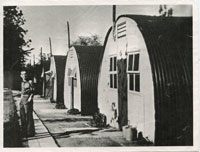
British staff huts Camp 260
Quick links on this page
Italian prisoners 1942
German POWs post-war 1946
Temporary housing 1948
Last tenants rehoused 1952
Hospital opened 1974
New hospital announced 2020
|
History of
Hardwick Heath, Hardwick Park and The Hardwick Estate
From Prison Camp to Housing and Leisure
|
1939
|
Please click here if you wish to go back to the story of Hardwick before World War II
|
1942
|
During 1942, some of the Italian prisoners from the North Africa campaign began to be accomodated within the UK. Camp number 56 was located at Botesdale, and there is some evidence that it housed Italian POWs during 1942. Camp number 85 was known as Victoria Camp, and was located on the Brandon Road at Mildenhall. It is unclear when it was established, but it certainly held POWs by October, 1944. Camp number 260 was in Bury St Edmunds, located at Hardwick Heath. It may be from a later date than these other two camps, as its number designation was so high.
|
|
|
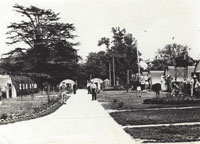
Prisoners at Hardwick Heath
|
|
1944
|
German Prisoners were taken in large numbers and reception centres were set up, from where they were dispersed to camps all over the country. One such camp, to be known as Camp 260, had been set up at Hardwick Heath. It was built of Nissen Huts, with four blocks of 16 huts in each block. Originally it had held Italian prisoners, but when Italy capitulated on 3rd September, 1943, these men could be replaced by Germans. Each hut held up to 60 men who cooked their own food from rations provided.
Meanwhile, pursuing its plans for post war housing, the Bury St Edmunds Borough Council purchased land sufficient for 700 houses on farmland which would become the Mildenhall Road Estate.
|
|
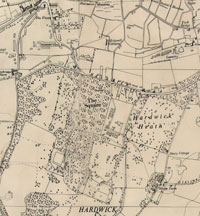
Map showing POW Camp
|
|
1945
|
The Second World War ended in Europe when VE Day was declared on 8th May 1945. For several months beforehand most of the local people and the prisoners at Hardwick knew that Germany was suffering a defeat. (VJ Day followed on August 15th.)
Colonel Victor Osborne was transferred to be commandant of the Hardwick Camp and its satellites with the ending of the war, but there were still hundreds of prisoners on site to be cared for. In all, the Colonel said there were still 2,000 prisoners at Hardwick and the surrounding satellite sites at farms and in villages.
|
|
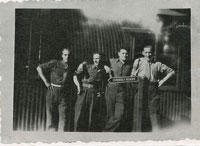
British staff by the Orderly Room
|
|
blank |
In war time the camp had been surrounded by a ten foot high wire fence which the Colonel had removed. However, the camp remained under military discipline, although rules were, naturally, relaxed somewhat. When two prisoners were put in the guardroom for a misdemeanour these two German prisoners, impatient to be released to return home, decided to escape by removing part of the roof. They made it to North Africa before they were recaptured by French forces.
Most of the prisoners went out working on local farms. Lorries would arrive to collect them in the mornings, and after roll-call they filed off to their transports. Some men worked at the sugar beet factory ensuring that the camp had ready supplies of sugar by smuggling it out through the factory searches.
In 1998 a former prisoner described how they occasionally brewed home-made schnapps from sugar beet.
Each camp had a designated Lagerfuhrer or camp leader, and the men had a bakery, tailor's shop, shoemakers, church and recreation hut.
Prisoner uniforms were khaki with yellow triangles on their trousers and a yellow circle on their backs. Italian prisoners had been adorned with these flashes in red.
|
|
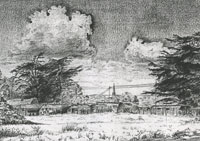
POW Camp on Hardwick Heath
|
|
1946
|
By September, 1946 there were still 386,000 German POW's in the UK working on the land and on reconstruction projects. They were paid the going rate for the job. The rule was enforced of "No Fraternising" even in church. One such camp was Camp number 260 at Hardwick Heath with about 64 huts. It was said to have contained Italian prisoners at first, following the victories in north Africa. As the war progressed there were more Germans captured. Parties of prisoners were collected by local farmers to work on the land, and Borough Council accounts show that some of the roads for the new Mildenhall Road estate were built by prisoners of war. A dozen or so POWs were regularly delivered for duties at Gibralter Barracks, where they worked in the messes, cookhouse, Quartermaster's Stores, and did odd jobs such as woodcutting and gardening. There were also camps at Mildenhall, Brandon, at Acton, near Sudbury and another at Botesdale. The German prisoners at Hardwick Heath had their own newsletter called "Lagerecho", which continued to be produced up to February 1948.
As well as the German POWs, there were large numbers of foreign troops who had fought alongside British forces, and now needed to be returned home. One particular group did not wish to return, and these were people whose homes were now under Soviet occupation or control. The Polish were particularly fearful of returning, particularly as Stalin had already deported a million Poles to Siberia during the years since annexation of eastern Poland under the Ribbentrop and Molotov Pact of late 1939. In addition, there were rumours about the Katyn massacre, which was a series of mass executions of Polish nationals carried out by the People's Commissariat for Internal Affairs (NKVD), the Soviet secret police, in April and May 1940. Some 250,000 Poles therefore chose to remain in Britain and were eventually joined by their families and dependents from wherever the war had left them. The only way such numbers could be accommodated was by placing them in camps recently vacated by the British armed forces or by the Americans. A Polish Resettlement Corps (PRC) was raised in 1946 as a corps of the British Army into which Poles were enlisted for the period of their demobilization up to 1948.
Where camps were housing Polish Families they were administered by a number of organisations including the National Assistance Board, Local Authorities and the National Service Hostels Corporation. One such camp in our area was Weeting Hall, just ouside Brandon, lasting from 1949 to 1955. By 1953 there were still 47 families in residence. There is also evidence that Rougham Camp housed Polish personnel in 1947, and there may have been Polish troops at Fornham Park camp in 1946 and/or 1947. Zosia Biegus of website "www.polishresettlementcampsintheuk.co.uk," informs me that, "I believe that Rougham Camp was used as short term accommodation for Poles who had chosen to return to Poland after the war."
On 15th September, 1946 the government announced that repatriation of German POWs would commence immediately, with an intention to return 15,000 a month, despite the serious lack of labour force in the country. It was hoped to replace the German labour with European Voluntary Workers, (EVWs) and men from the Polish Resettlement Corps. The EVWs were largely Ukrainian, Polish and Latvian unskilled men, part of the millions of displaced persons currently impoverished around the continent. It was hoped to recruit 90,000 such men. There were plenty of objectors to repatriation, but humanitarian arguments finally prevailed.
Many peace celebrations were held in 1946 both to give time to organise them, and to wait for the better weather. In addition it took many months for Far-East prisoners of war to return.
|
|
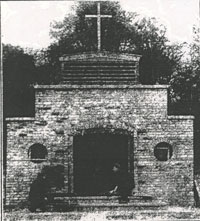
Hardwick POW Chapel
|
|
blank |
On December 20th, 1946, the Bury Free Press reported that German POWs were busy converting one of the nissen huts at Hardwick into a church in readiness for their Christmas services. The church was intended to serve both Catholics and Protestants and would seat 300 although the camp holds over 600. The men have their own orchestra and choir.
|
|
1947
|
The opening winter of 1947 continued to be very bad. Heavy snow blocked the roads, including the notorious Chedburgh Straight, where snow lay many feet thick through February. Electricity cuts were frequent and severe, affecting industry as well as homes. Greene King only brewed once a week in February, just to keep the yeast alive. Worse would follow when the snow melted.
In March, 1947 occurred the last great flooding of the Fens. Dykes were breached all across the Fenlands from Suffolk to Lincolnshire. Some 3000 acres of Lakenheath Fen were inundated and the floodwaters reached to the edge of the village. The Womens Land Army was still in operation, and the Lakenheath hostel, being situated at a low point at the north end of the High Street, was flooded - including the dormitories, the water being right across the road. The W.L.A. girls were evacuated to a large house at Risby and elsewhere until the floods receded.
RAF Mildenhall was mobilised to help rescue the flood victims. The worst day was 16th March, when 110 flood victims were collected by RAF Mildenhall transport and given temporary accomodation on the base. Some 44 NCOs and men were then deployed to Lakenheath Lode on 22nd March to help with heavy flood relief work. On 23rd March, another party of 28 volunteers and 36 former POWs went to help at Southery Pumping Station. Flooding was less bad during April, but RAF Mildenhall continued to supply lighting equipment to allow night working to help restore the damage.
POWs from Hardwick Camp were also deployed to help with clearing fallen trees, dead sheep and other debris after the floods.
|
|
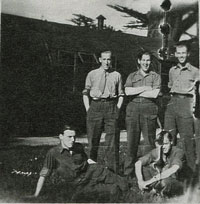
British staff at Hardwick
|
|
blank |
The staff at POW camps received further duties allocating gradings to each prisoner.
Nationally, repatriation of prisoners was a slow process. In April, 1947 15,515 prisoners were returned home. POWs were interviewed and graded into categories:
- Grade A - high priority and fit for release
- Grade B
- Grade C - ( no grade Cs got released in 1947)
- Sick and wounded
- Needed to rebuild Germany - with specialist skills
- Compassionate grounds
- Special Cases
The Hardwick Camp newsletter, called Lagerecho, offered the following advice in its issue of 31st August, 1947, concerning the British Government's plans to give priority release to prisoners with compassionate reasons.
"It has been announced that in many cases prisoners of war receive reports of their wives having extra-marital relationships with other men. Until now it has not been permitted for the POW to seek early release in such cases on the grounds of family problems. It has been decided that applications on the above grounds will, from now on, be looked into.
Such applications must however be accompanied in every instance by an official confirmation that the couple's children are suffering as a result of the wife's bad conduct."
Through 1947 the Suffolk Free Press reported various incidents involving German POWs, who were awaiting repatriation.
August - "The Suffolk Football Association have ruled that German P.O.W.’s may not play for civilian clubs in the league games but games between civilians and P.O.W.’s may take place with the consent of the camp commandant and no admission charges may be made."
October16th - "German P.O.W.’s from Halstead, Borley and Liston almost filled the public section of Sudbury Town Council on Tuesday night to watch how Local Government conducted their affairs."
During October, five German P.O.W.,s were fined 10s each for distilling spirits without a license at Tendering Hall Camp at Stoke by Nayland.
The availability of sugar beet on the local farms and from the beet factory meant that home-made schnapps was also ocaasionally produced illicitly at Hardwick Camp.
In December 1947, the Suffolk Free Press reported that, "In recognition of his bravery in rescuing a Lawshall man from an attack by a bull, a German P.O.W. Godfrey Dappert of No 260 P.O.W. Camp, Hardwick has received an illuminated address from the Carnegie Trust and a watch suitably inscribed, the presentation was made by Brigadier J.Slater O.B.E., Deputy Commander of the East Anglian District at a ceremony on Hardwick Heath." The Lawshall man in question was the farmer Mr W Rose, and Herr Dappart had been working on his farm when the bull became enraged.
|
|
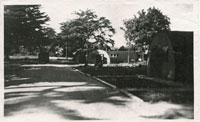
POW Camp empty July 1948
|
|
1948
|
By November 1948, the last German POW's in the country were sent home, of those who wished to go. Some stayed because their homes were now within the Soviet bloc. Others found local jobs or local girls. The Lagerecho newsletter of the German prisoners at Hardwick Heath, had already had its final issue in February 1948, and by summer the Hardwick camp was abandoned.
Hardwick Camp was closed and locked up in July, 1948, by Camp Orderly Joe Brooks who later became Rector of St Leonard's church in Horringer.
At least one family took matters into their own hands and took over the quarters previously occupied by Colonel Osborne, the last British camp commandant from 1945 to 1948. He had now retired to Great Barton. These squatters were visited by council officials and evicted by the police, returning after officialdom had left. They remained for six months before the "official" tenants began to arrive in November and December.
The Borough Council's Housing Construction Committee held a special meeting on 22nd July, 1948, to consider the future of the huts at Hardwick Heath Camp and the Huts at the rear of the Flax Factory, Hardwick Road. At Hardwick Heath it was reported that plans were in hand to convert the huts into living units for temporary housing accomodation for a 5 year period. Water stand pipes were to be installed at intervals and a maintenance fitter would be engaged to maintain the water and sewerage services. Plans drawn up by Mr H Lister Coates would need to be submitted to the Ministry of Health for approval.
As for the huts behind the Flax Factory, the committee hoped to persuade the Hand Laundry, (now in the Flax Factory premises) to take over these huts for temporary accomodation.
Contractors began work on converting the nissen huts to living accomodation in October, 1948. Footpaths on the site had been closed to the public while the POWs were in residence. These now had to be officially opened again by judicial orders.
The work was in three phases, tendered seperately. Group A was priced by Mr L C Pearson at £3,250-9s-0d; Group B was won by Mr A Bland at £4,594-10s-6d and Group C went to Messrs Moore Bros for £3,198-19s-0d. A few buildings were demolished, and remainder produced 56 living units.
At Hardwick Heath, the huts which had housed POW's were now pressed into service as temporary housing while families were waiting for one of the new houses on the Mildenhall Road Estate, or for a prefab elsewhere in the town as they became available. Many of these were ex-servicemen with new wives and babies.
The first residents, properly allocated a place by the council, moved in by the end of 1948. One such early family was Mr and Mrs Clarke.
|
|
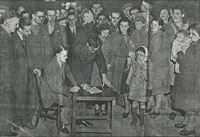
Hardwick Camp petition
|
|
1949
|
In January 1949 the Eastern Electricity Board laid on electricity to the camp but living conditions continued to be difficult.
While some families had moved in, work continued on the remaining dwellings at the camp. This inevitably led to conflicts.
On 1st April, 1949, the Bury Free Press reported on a "rebellion smouldering" at Hardwick Camp. Tenants met to form a Ratepayers Association, led by Mr J Bishop to protest to the council against rubbish and builders rubble left around the camp. They also wanted a housing points allocation system to ensure fair treatment in allocating permanent homes to residents. The current rent of 14/- a week should be cut to 8/6d Mr Bishop said. Mr Woodhouse pointed out that the nearest telephone was three quarters of a mile away and a proposed communal laundry was impractical and ill sited. Tenants had to do all the day to day maintenance themselves.
Of the 36 families on site, 35 had signed a petition to the council asking for a water supply and a small copper to each hut, proper drains and drainage, and a rent reduction.
On 13th May the Bury Free Press reported the re-opening of the chapel at Hardwick Camp for the use of the residents. The Revd. A C Pelly of St Mary's church presided over the ceremony. Hardwick Camp with 35-40 families needed its own "parish" church said Mr Pelly. Repairing the derelict chapel cost £6 and 5/- a week was needed for its rent. It would be run on multi-denominational grounds and donations were made by the Congregationalists, Methodists and Baptists as well as St Mary's church. Mr Woodhouse, chairman of the camp ratepayers association thanked all concerned for their voluntary efforts.
The work on converting all the huts did not finish until July, 1949.
The council fenced off the pond nearby to protect any small children who might visit.
The GPO was asked to install a telephone kiosk nearby. This arrived around this time near to the post-box outside the main entrance to the heath. Just in time for Christmas, 1949, the Eastern Counties Omnibus Co provided a regular bus service between Hardwick Lane and the town centre.
|
|

Plan of typical dwelling unit |
|
1950
|
The new homes consisted of a kitchen and a tiny store room, with a living room and two bedrooms. There was no running water and a small coal-burning kitchen stove was used for heating and for cooking. Eight homes shared a standpipe, but there was no proper sewage disposal system. There was electric lighting, but no telephone. Each hut now had a small garden at the rear and a few people kept chickens, geese or rabbits. One tenant got permission to keep pigs, provided they did not cause a nuisance.
Tenants attempted their own draught proofing and decorations, but conditions were damp and freezing in winter and excessively hot in summer.
This sketch was drawn by Frank Whitnall from descriptions taken in March, 1996, from Mrs Peggy Clarke, resident from December 1948, when they were one of the first "official" tenants. They stayed until 1951, when they moved to a council pre-fab in Priors Road.
Mr J Filkins opened one of the huts as a greengrocers and general store, paying the usual 10/- a week in rent. Finch's West End Bakery supplied bread and a local roundsman delivered milk.
|
|
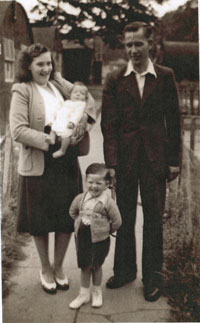
Hoddy family at Hardwick Camp 1951 |
|
1951
|
Families who were prepared to go into the Hardwick Heath huts felt they should be given first choice of a new house on the Mildenhall Road Estate as these were slowly completed. However, council policy was that allocation of this temporary accomodation in no way prejudiced applications for a more permanent home.
Mr and Mrs Clarke had been one of the first to move in in December 1948, and now, with a new baby, they moved to one of the newly erected pre-fabs in Priors Road.
Mr and Mrs Hoddy had been living in Nowton Road with Mrs Hoddy's parents.They had one son, Brian, and when a daughter came along in April, 1951, they were allocated Unit 56 at Hardwick Camp.
|
|
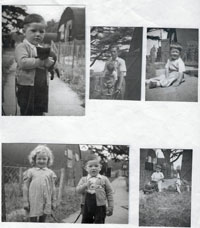
Life at Hardwick Heath |
|
1952
|
By now most of the families at Hardwick Heath, living in the old POW camp, had been rehoused on the Mildenhall Road Estate. The little boy in these pictures is Brian Hoddy. In June 1952, Mr and Mrs Hoddy and their two small children were allocated a council house in Bunbury Road, on the Mildenhall Estate which was under construction.
|
|
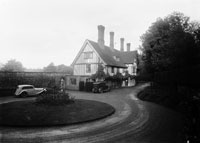
Life at Hardwick Manor |
|
1953
|
Local builder Leonard Sewell, colloquially known as Lennie, purchased Hardwick Manor in 1953 for a rumoured sum of £20,000. He later became mayor of Bury St Edmunds. For many years the annual Hardwick Fete in aid of the hospital was a popular attraction in the grounds of Hardwick Manor.
|
|

Map showing POW Camp / temp homes
|
|
1958
|
This OS six inch scale map, (1:10560), was issued in 1958, but probably surveyed a year or two earlier. It shows the remaining huts from the Prisoner of War camp, possibly a bit changed in order to make them in to habitable temporary accomodation for families as they awaited the allocation of permanent homes on the Mildenhall Road estate or in any other of the housing projects being carried out by the Borough Council.
|
|
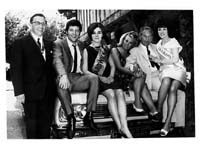 Tom Jones 1965 Fete
Tom Jones 1965 Fete
|
|
1965
|
At this time there was a fete held every year in the grounds of Hardwick Manor. Every year a popular celebrity would attend, and in 1965 Tom Jones, the singer, was welcomed. He remains a popular singer in 2022.
|
|
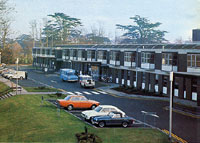
West Suffolk Hospital
|
|
1974
|
In 1974 the new West Suffolk Hospital was opened in Hardwick Lane, Bury St Edmunds. The old hospital in Hospital Road was soon abandoned, and its patients moved to the modern splendour of Hardwick.
Hospital Road retained its name despite the lack of the hospital. It had previously been called the Chevington Road, which was itself an old name from a previous time when it led along the River Linnet as the Chevington Way, in the days before Lord Bristol had enclosed Ickworth Park.
|
|
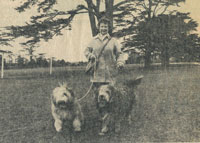
Hardwick Heath dog walkers
|
|
1980
|
On 5th November, 1980, the East Anglian Daily Times reported on "Hardwick Heath war memories revived by visitors from the past." For visitors from the past all that remained was a concrete path between where the huts stood. Some visitors also called on Col F V Osborne who was commandant for two and a half years after VE Day. He remembered a happy camp where men worked on farms and made toys and craft items out of wood in their evenings. Hardwick had 600 men on site, but covered up to 2,000 including those billeted on farms and other satellite out-stations. "They were very disciplined and very clean." Mr Roland Williams was former barracks inventory accountant and found that the Lagerfuhrer spoke perfect English as he had also been a POW in England in the 1914-18 war. He reported that everything here was extremely well run. "I was dealing with British and Italian camps as well and I never went into a camp so well-run."
One thing that did surprise Mr Williams was the freely available sugar in the tea he was given on site. Civilians were tightly rationed but POWs working at the sugar beet factory could smuggle out supplies in hollowed out loaves of bread.
|
|
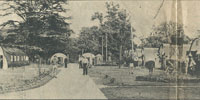
Behind the Wire
|
|
1987
|
On May 8th, 1987 the Bury Free Press published a feature entitled, "Behind the wire" describing the life of wartime POWs at Hardwick Camp. Three former prisoners who had settled in Bury St Edmunds were asked for their recollections.
|
|

Three ex-POWs
|
|
blank |
Rudi Gross was struck by the warmth and friendship shown by the people of Bury. One local man handed out 60 cigars at Christmas. They had a theatre, film shows and sports events, and a bakery for bread. They put on an exhibition of paintings and crafts where local people could buy objects. Schnapps from sugar beet pulp was hidden under the chapel altar.
Johann Hopfensperger was another POW who was now known as John and ran a popular fish and chip shop in Risbygate Street. He said, "I have no bad memories of the camp and I decided to stay in England after the war because of the friendliness of the people."
Emil Weingaertner was on a navy minesweeper captured in the Channel Islands in May, 1945. He held the Iron Cross, first class, and remembered spending more time working on farms than being in the camp.
|
|
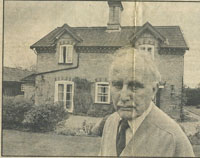
Col Osborne retd
|
|
blank |
Also interviewed were the Camp Commandant, Colonel Victor Osborne now retired of Great Barton. "Initially there were Italians there. They left and the Germans arrived soon after", he told the BFP. He was responsible for over 2000 prisoners at both Hardwick and its village satellites.
|
|
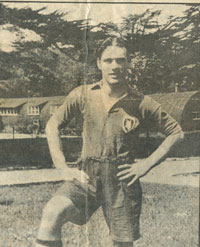
Sgt Joe Brooks
|
|
blank |
The Revd Joe Brooks was orderly room sergeant at the camp from 1947 until he closed it in July, 1948 for the last time. "On the whole relations were very good.....They were happy times...It was certainly the end of an era and I felt quite sad."
Mr Brooks most vivid memories were of the camp staff football matches against the prisoners, "They were very competitive games, and could be very tough. It resulted in the settling of many old scores, and we never won because they had more players to choose from." Mr Brooks even took a party out of the camp to watch Ipswich Town play.
In 1987 Mr Brooks was the rector at St Leonards Church in Horringer.
|
|

Football changing rooms
|
|
1992
|
At Hardwick Heath a block of changing rooms with toilets were built for the use of local football teams playing on the Heath pitches. Accomodation and offices for the park ranger were included above. The car park was soon extended and improved as well.
|
|
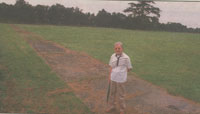
Hardwick and Rudi Gross
|
|
1998
|
The Bury Free Press of July 31st, 1998, carried a story of "Bury's POWs remember Camp 206." In fact, Hardwick Camp was Number 260. Ex naval seaman Rudi Gross had been captured at the end of the war, and after starving for three months at the grossly overcrowded Bretzenheim camp, he was sent to Camp 260 in England. He described Hardwick as like a holiday camp compared to conditions back in Germany. He worked on farms in the area, recalling the kindness of farmers and local people, and met and married an English girl. For years he was working as a milkman on the Mildenhall estate. When he took one of his sons to scout camp at Hardwick Heath, the roadways which remained brought back memories of his time there after the war. "I would not change a thing".
|
|
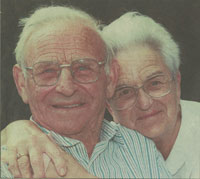
Emil and his wife 1998
|
|
blank |
Another interviewee was Emil Weingaertner, a Romanian who had served in the German Navy on minesweepers. He won the Iron Cross for shooting down a Spitfire over the North Sea. In 1948 he was offered to be repatriated to Germany but found he would be a displaced person facing further internment. After the camp closed he was allowed to stay to work. He found a job as a cowhand and then a general farmworker on three farms. He was paid 1/- a week into his bank in Germany. He met his English wife while travelling to work on the bus to William Driver's farm at Chedburgh. "I have no complaints about my time as a prisoner. The farmers were very good to us,as were the local people."
|
|
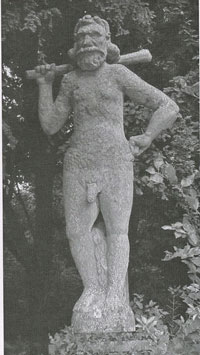
Hercules restored again
|
|
2000
|
At Hawsted the villagers had the idea to produce a village survey to celebrate the millennium in the manner of a local Domesday Book. By now the village was spelled with an "A", thus "Hawstead 2001" was the name whch they published their great survey under. This lavish publication of 280 pages covered all aspects of the parish, its industry, church and people. The entry for Hawstead Place Farm by Ben Powell included mention of the statue "Hercules". The broken and dismembered statue was rescued in the 1960s by Oliver Powell and was eventually repaired by Michael Black, a sculptor. He was unveiled in 1978, some 400 years after the visit of Queen Elizabeth I.
|
|
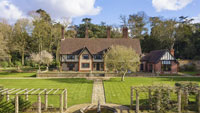
Hardwick Manor for sale
|
|
2020
|
During the height of the Coronavirus pandemic one bright spot for local people was the announcement in October, 2020,that the West Suffolk NHS Foundation had agreed to purchase the eight bedroom Hardwick Manor and its 70 acres of grounds, for £3.5 million. The Foundation had considered several sites for a replacement to the ageing West Suffolk Hospital, but this site seemed ideal as it was immediately adjacent to the old hospital and could make use of its more recent upgrades and improvements while replacing the decayed parts of the old hospital with the least possible disruption.
|
|
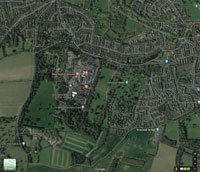
Hardwick from the air
|
|
2022
|
Using Google Earth shows us a birds eye of the Hardwick area, as seen in 2022. The area of public open space as it is today is labelled Hardwick Heath. It is wrapped around by private housing on the right of the view, off Home Farm Lane. The central area is dominated by the West Suffolk Hospital and the St Nicholas Hospice. At the bottom are the parallel lines of pheasant pens of the Hardwick Game Farm. To the left of the hospital is another open space made up of Hardwick Manor - land now designated for a new hospital. Between Hardwick Manor and the hospital is Sharp Road, another development of private housing.
|
|
Quick links on this page
Top of page 1942
German POWs post-war 1946
Temporary housing 1948
Last tenants rehoused 1952
Hospital opened 1974
|
Prepared for this St Edmundsbury website
by David Addy, 21st January, 2022
Books and other resources consulted:
Much of the research on the POW camp and subsequent temporary housing was collected in a folder by the late Frank Whitnall
Frank's papers were later passed to Martyn Taylor, who kindly supplied them for this website's use.
"Lost Country Houses of Suffolk" by W M Roberts, 2010.
Moyse's Hall Museum Picture collection
Suffolk Record Office, Bury St Edmunds
| |




























